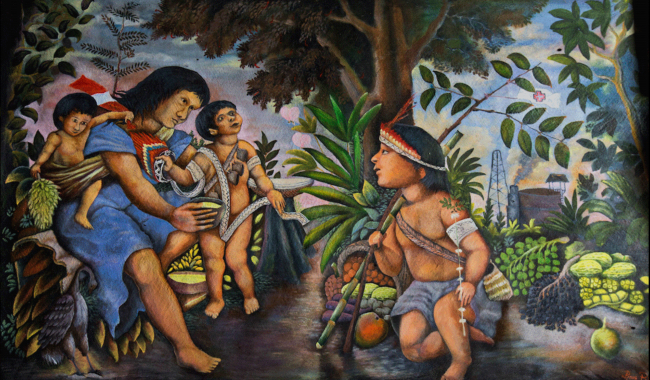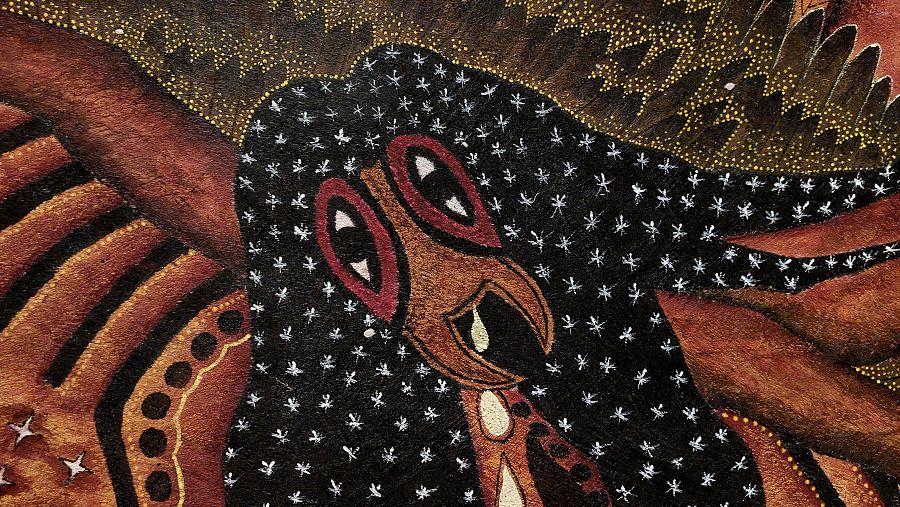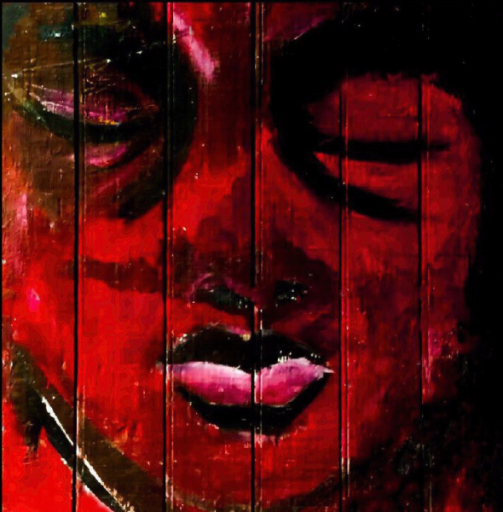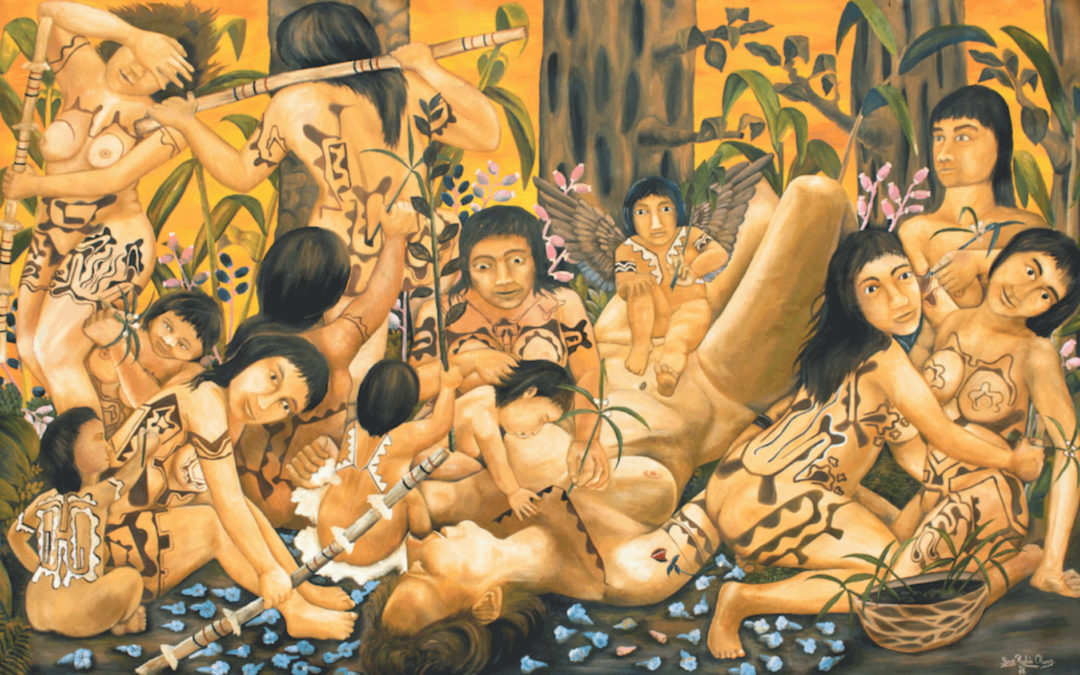Arte contemporáneo del Amazonas
El arte contemporáneo del Amazonas trasciende lo estético. Como una expresión viva de la cosmovisión indígena y de la profunda conexión espiritual con la naturaleza, sitúa al ser humano dentro del cosmos de la selva. Encierra el diálogo continuo entre cultura y cosmos, entre el ser humano y el inmenso mundo del Amazonas.
Cultura e identidad del Amazonas
Las pinturas de los pueblos indígenas del Amazonas son mucho más que obras de arte: son crónicas vivas. Su lenguaje visual, potente y simbólico, abre una ventana a un universo de seres espirituales y revela una comprensión única del cosmos y de la existencia humana. En ellas reconocemos cómo el saber ancestral y la profundidad espiritual sustentan una identidad que concibe al ser humano como parte integral de la naturaleza.
El arte como práctica espiritual
Esta visión se materializa en la tradición artesanal: los patrones arcaicos de la cerámica, las plumas luminosas de las máscaras ceremoniales. No son simples ornamentos, sino portales hacia un mundo donde lo físico y lo espiritual se entrelazan. Máscaras, ornamentos corporales y vestimentas son, por ello, medios esenciales en rituales y ceremonias: instrumentos de comunicación con el mundo espiritual, de invocación de fuerzas y de resguardo del bienestar colectivo.

Memoria y responsabilidad histórica
Pero el arte no solo preserva la cultura viva, sino también su memoria colectiva. Es un testimonio del dolor histórico. Durante el auge del caucho, los pueblos indígenas sufrieron un trauma profundo, una verdad muchas veces silenciada. Hoy, los artistas indígenas enfrentan esa herencia en sus obras y aseguran que dichas memorias permanezcan.
Yo mismo he sentido el peso de ese pasado. De noche, junto al fuego, escuché a los ancianos relatar los horrores padecidos por sus antepasados. Ese trauma aún resuena en las comunidades, como un eco persistente de heridas que atraviesan generaciones. En este arte habitan ambas dimensiones: la fuente de una identidad espiritual y el archivo incorruptible de un dolor colectivo. Es la llave que permite comprender a los pueblos del Amazonas en toda su profundidad y complejidad.
La estética de la emancipación en el Amazonas
En los últimos años, el arte del Amazonas ha adquirido una relevancia creciente en la escena cultural internacional. Cuestiona las concepciones tradicionales del arte y la cultura, y amplifica las voces de las lideresas y líderes indígenas de la región. Hoy se ha convertido en una plataforma influyente en la lucha por los derechos indígenas y la protección de los territorios ancestrales.
Esta práctica artística desafía radicalmente las nociones convencionales del arte y otorga un nuevo peso a las perspectivas indígenas. Inicia una redefinición constante de los símbolos culturales: un proceso que las propias comunidades conducen de manera autónoma, reinterpretando sus signos y afirmando con soberanía sus significados.
Del objeto etnográfico al sujeto político
También ha cambiado el papel de las y los artistas. Donde antes se les clasificaba como representantes de tradiciones folclóricas, hoy reclaman un reconocimiento más amplio y deciden por sí mismos cómo se categorizan y difunden sus obras. Este cambio de conciencia transforma profundamente la percepción: el arte amazónico ya no se considera un simple patrimonio etnográfico, sino un archivo vivo y una poderosa expresión política.
Su manifestación más visible y concentrada se encuentra en los grandes murales. Estos se han convertido en auténticos manifiestos del activismo ambiental. Las y los artistas indígenas transforman muros en voces públicas: su lenguaje visual denuncia la destrucción de la selva y la amenaza que pesa sobre sus comunidades, exigiendo con claridad la defensa de la tierra y modos de vida sostenibles.
La voz de la selva — El arte como mensaje
El arte contemporáneo del Amazonas no denuncia: ofrece esperanza. Las y los artistas llaman al mundo, a través de sus poderosas pinturas y su apasionado compromiso, a reconocer el valor inalienable de la selva y de quienes la habitan. Sus obras se convierten en la voz misma del bosque, una voz que nos exhorta a ser guardianes responsables de este ecosistema insustituible.
Un lenguaje universal más allá de las palabras
En un mundo marcado por la diversidad cultural y la vulnerabilidad del planeta, el arte amazónico abre un espacio de conexión: un lenguaje universal más allá de las palabras, que trasciende fronteras. Ya sea en los patrones ancestrales de los Shipibo-Konibo, en la estética mítica de los Huitoto o en las representaciones espirituales de numerosos pueblos, su simbolismo promueve la comprensión y el respeto a través de los continentes. Al adentrarnos en las historias que encierran estas obras, comenzamos a descubrir las múltiples visiones del mundo que representan —y la profunda interdependencia de toda forma de vida que les da sentido.
De la empatía a la acción
Este descubrimiento despierta empatía e impulsa al compromiso. Así, el arte mismo se convierte en un llamado a reconocer la amenaza que enfrenta el Amazonas y a asumir nuestra responsabilidad compartida en su protección. En mi trabajo con artistas de la región amazónica, he podido experimentar cómo sus obras conmueven y transforman a quienes las contemplan. Cuando nos reconocemos en sus imágenes vibrantes, se vuelve tangible una visión: un futuro en el que humanidad y naturaleza no existan separadas, sino que prosperen como una sola unidad.
La superación de la separación: el arte como reflejo de la interconexión
El arte amazónico es el suelo fértil en el que depositamos la semilla de nuestra mirada. Solo cuando nos adentramos en los surcos de esa tierra —en su luz y en su sombra—, comienza a germinar el verdadero pensamiento. Así se nos permite no solo contemplar la cosmovisión que habita en esta forma de arte, sino también sumergirnos en ella y comprenderla.
Esa inmersión conduce, finalmente, a una comprensión existencial: el reconocimiento de la conexión fundamental de toda forma de vida, una conexión que este arte no solo representa, sino que encarna en sí mismo. Así, deja de ser objeto para convertirse en experiencia —en un encuentro.
Pensamiento indígena: la unidad de toda vida
Esta comprensión más profunda va más allá del simple entendimiento. Disuelve la aparente separación entre quien mira y lo mirado, entre la cultura humana y el ecosistema natural, revelándola como una ilusión. En el reflejo de este arte, dejamos de reconocernos como observadores externos para percibirnos como parte del universo representado.
Así, cambia también nuestra percepción de la crisis ecológica: deja de parecer una amenaza abstracta que afecta a un “otro” distante y se muestra como una alteración fundamental dentro de la red de relaciones a la que pertenecemos inseparablemente. El arte establece, de este modo, el fundamento ético para una acción que nace de la conexión, no de la obligación, y proyecta la visión de una futura simbiosis.

Inspiración para una convivencia armónica
El arte del Amazonas es mucho más que un deleite visual: es una expresión viva de identidad cultural, un llamado ecológico a la acción y un puente entre mundos. En él se manifiesta cómo el conocimiento indígena puede guiarnos hacia un futuro más sostenible y justo.
Estas obras transmiten, con intensidad, la belleza y la fragilidad de la selva. Nos recuerdan que la protección del Amazonas —de sus ecosistemas, de sus pueblos y de su biodiversidad irremplazable— no es un deber distante, sino una responsabilidad inmediata que nos involucra a todos.
En tiempos de crisis ecológica y divisiones sociales, necesitamos precisamente este arte: como fuente de inspiración, como llamado a despertar y como guía hacia una vida en la que humanidad y naturaleza no estén en conflicto, sino en armonía.
Descubra las obras contemporáneas del Amazonas en nuestra colección y únase a este movimiento de valoración cultural y responsabilidad ecológica.
Author Rolf Friberg
Articulos Relacionados

Arte Indígena Contemp. Santiago Yahuarcani
Artista Uitoto revolucionario trae la memoria ancestral al presente, transformando la cosmovisión y el conocimiento espiritual en expresiones contemporáneas.

Arte Indígena Contemp. Santiago Yahuarcani
Artista Uitoto revolucionario trae la memoria ancestral al presente, transformando la cosmovisión y el conocimiento espiritual en expresiones contemporáneas.

Arte Indígena Contemp. Santiago Yahuarcani
Artista Uitoto revolucionario trae la memoria ancestral al presente, transformando la cosmovisión y el conocimiento espiritual en expresiones contemporáneas.


0 comentarios